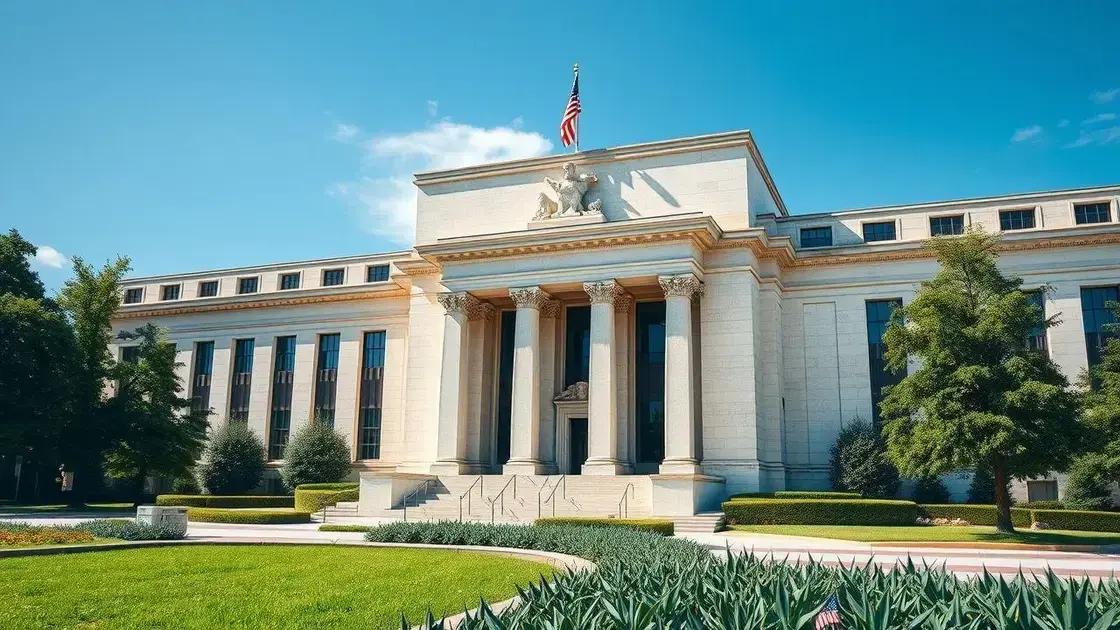Maintaining strict monetary policy at Fed: what you need to know

Maintaining strict monetary policy at the Fed involves controlling interest rates and inflation through tools like the federal funds rate, impacting economic stability and influencing consumer borrowing and spending.
Maintaining strict monetary policy at Fed is crucial for economic stability. But have you ever wondered how it influences your finances and the broader market? Let’s dive into these dynamics.
Understanding the Federal Reserve’s Role
The Federal Reserve plays a vital role in maintaining strict monetary policy. Its main goal is to ensure a stable economy. By controlling the money supply and setting interest rates, the Fed influences economic conditions across the United States.
Core Functions of the Federal Reserve
Understanding how the Fed operates begins with its core functions. The Reserve has several key responsibilities that shape monetary policy:
- Regulating banks and ensuring financial stability
- Managing inflation through interest rate adjustments
- Providing financial services to the government
- Monitoring economic trends and data
As the central bank, the Fed also influences how much money is circulating in the economy. When it decides to raise interest rates, borrowing becomes more expensive. This can slow down spending and investment, which is helpful in curbing inflation. Conversely, lowering rates can encourage borrowing and stimulate economic activity.
Impact on the Economy
The decisions made by the Fed can have huge impacts. For example, when the Fed increases interest rates, consumer borrowing becomes pricier. This often leads to lower levels of spending in various sectors, particularly housing and business investment.
Awareness of the Fed’s role can help individuals make informed financial decisions. Understanding these dynamics allows consumers to better prepare for changes in the economy.
Overall, the Federal Reserve’s management of monetary policy is crucial for navigating the economic landscape. By keeping a close eye on the Fed’s actions, you can gain insight into potential changes in interest rates and the overall health of the economy.
Key components of strict monetary policy
Key components of strict monetary policy are essential for controlling inflation and ensuring economic stability. The Federal Reserve uses several tools to achieve its goals. Understanding these components can help you see how monetary policies affect everyday life.
Monetary Policy Tools
One key tool is the federal funds rate. This rate influences how much banks pay to borrow money. When the Fed raises this rate, it becomes more expensive for banks to borrow, which in turn raises interest rates for consumers and businesses.
- Open market operations
- Reserve requirements
- Discount rates
- Forward guidance
Open market operations involve the buying and selling of government securities. By purchasing securities, the Fed injects money into the economy. Conversely, selling securities pulls money out of circulation. This action can shift the amount of cash available for lending.
Inflation Targeting
Another critical aspect is inflation targeting. The Fed aims for a specific inflation rate, usually around 2%. This target helps guide monetary policy decisions. By keeping inflation stable, the Fed supports sustainable economic growth and provides predictability in the market.
Another significant component is managing the money supply. The Fed adjusts the available money in the economy to promote growth while avoiding excessive inflation. This balancing act plays a vital role in maintaining a healthy economic environment.
On a broader level, strict monetary policy also includes monitoring economic indicators such as unemployment rates and GDP growth. This analysis helps the Fed make informed decisions. By examining these factors, the Fed can anticipate changes in the economy and act proactively.
Impacts on economic stability

Impacts on economic stability arise significantly from the actions taken by the Federal Reserve. When the Fed implements a strict monetary policy, it directly influences both inflation and employment rates. Understanding these impacts is crucial for grasping how national policies affect your personal finances.
Effects on Inflation
A primary goal of strict monetary policy is to control inflation. When the Fed raises interest rates, borrowing costs increase. This leads to reduced consumer spending and investment, which can help lower inflation rates. By keeping inflation in check, the Fed contributes to a stable economic environment.
- Lower inflation means better purchasing power for consumers.
- Stable prices encourage longer-term financial planning.
- Decreased inflation risk fosters investment in businesses.
- Healthy inflation rates support job creation.
On the contrary, if monetary policy is too loose, inflation can spiral out of control. High inflation can erode savings and create uncertainty in the economy. Therefore, maintaining a delicate balance is essential for overall economic health.
Influence on Employment
The relationship between monetary policy and employment is another essential factor. Tightening monetary policy can slow economic growth, impacting job creation. However, if the economy overheats due to low interest rates, it can lead to unsustainable employment gains.
Moreover, when people feel confident in their jobs, they tend to spend more. This spending stimulates the economy further. A stable job market, supported by appropriate monetary policy, creates a positive feedback loop that is beneficial for everyone.
How it affects interest rates
How it affects interest rates is a key aspect of understanding strict monetary policy. The Federal Reserve influences interest rates primarily through its control of the federal funds rate. This rate affects how much banks charge one another for overnight loans. Changes to this rate have a cascading effect on consumer borrowing and lending practices.
Mechanisms of Change
When the Fed raises the federal funds rate, it typically leads to higher interest rates across the board. This means that loans for homes, cars, and businesses become more expensive. As a result, consumers may think twice before taking on new debt.
- Higher interest rates slow down borrowing.
- Reduced borrowing can lead to lower consumer spending.
- Higher rates can cool down an overheating economy.
- They also help in maintaining lower inflation.
Conversely, when the Fed lowers interest rates, borrowing becomes cheaper. This encourages spending and investment, stimulating the economy. Many people look to buy homes or start businesses during these times because the lower costs make it easier to manage their finances.
Market Reactions
The relationship between interest rates and economic activity is vital. Changes in interest rates can influence stock prices and consumer confidence. For instance, lower rates may lead to a surge in stock markets, as companies often use cheaper loans to expand and invest.
People who understand how these interest rate changes work can make better financial choices. Monitoring the Fed’s actions helps you strategize your borrowing or saving, allowing you to take advantage of favorable economic situations.
Future trends and considerations
Future trends and considerations in monetary policy are crucial for understanding how economic conditions may evolve. As the Federal Reserve continues to adjust its strategies, the impact on interest rates, inflation, and overall economic growth becomes increasingly apparent.
Emerging Economic Factors
One trend to watch is the rise of digital currencies and their potential influence on traditional monetary policy. As central banks explore digital currencies, this may lead to changes in how money supply is controlled. The integration of technology in banking and finance could reshape how the Fed implements its strategies.
- Increased focus on financial technology (fintech) innovations.
- Potential regulations regarding digital currencies.
- Changing consumer behavior due to technology.
- Adoption of blockchain technology for financial transactions.
Another consideration is the ongoing impact of global economic events. Issues like geopolitical tensions and trade agreements can significantly influence the U.S. economy. For instance, disruptions in supply chains could lead to inflationary pressures, causing the Fed to respond with more stringent monetary policies.
Long-Term Projections
In the long run, the Fed may need to rethink its approach to inflation targeting. With recent economic shifts, a more flexible targeting strategy could be beneficial. This adaptability may allow the Fed to address changing economic conditions promptly.
Additionally, as demographic trends evolve, the Fed must consider how workforce changes affect the economy. A growing population could demand more jobs, influencing monetary policy. Adjustments in policy will be necessary to ensure economic growth aligns with societal needs.
In conclusion, understanding the complexities of maintaining strict monetary policy at the Federal Reserve is vital for anyone interested in economic trends. The decisions made by the Fed influence interest rates, inflation, and overall economic stability. As we look to the future, it’s important to keep an eye on emerging trends, such as digital currencies and global economic shifts. By staying informed, you can better navigate the financial landscape and make smarter personal finance decisions.
FAQ – Questions About Maintaining Strict Monetary Policy at the Fed
How does the Federal Reserve affect interest rates?
The Fed influences interest rates by adjusting the federal funds rate, which impacts borrowing costs for consumers and businesses.
What is the relationship between strict monetary policy and inflation?
Strict monetary policy aims to control inflation by raising interest rates, which can slow down spending and investment in the economy.
What role do global events play in U.S. monetary policy?
Global events can greatly impact U.S. economic conditions, prompting the Fed to adjust its policies to maintain stability.
What trends should we watch for in the future of monetary policy?
Emerging trends such as digital currencies and technological advancements in finance could reshape how the Fed develops its monetary strategies.






